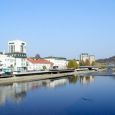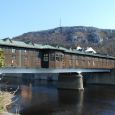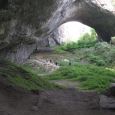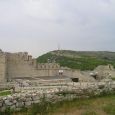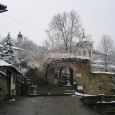Lovech
Advertisement
By Road
Two main transport thoroughfares pass through the territory of the region- road /highway/ I - 4 (Sofia, Sevlievo, Veliko Tarnovo Shumen) and road /highway/ I - 3 (Botevgrad, Koritna, Byala).Both connect the region of Lovech with the neighboring and the other regions and with the capital city. Important transport thoroughfares for the region are: road II - 35, forming the north - south transport axis, providing the connection between the regions of Pleven and Plovdiv, through the Troyan - Karnare Balkan pass.
By Bus
There are regular bus lines to Sofia, Pleven, Troyan, Teteven, Sevlievo, Gabrovo, Veliko Turnovo, Levski and other smaller settlements within the region.The bus station and the railway station are located not far from each other in the western part of the town.
By Train
Lovech is a transitional station of the railway line Levski - Troyan, linking it to the national railway network.There is a town bus transport functioning in Lovech.
Advertisement
Devetashka cave
is one of the biggest caves in Bulgaria.Located in the municipality of Lovech.Devetashka cave was discovered in 1921, the The total length is 2442 m, total area is 20,400 m 2, height - 60 m. It is located about 15 km. northeast of Lovech, near the village Devetaki the east bank of the river Osam.Access to the cave is more than a kilometer long trail that begins shortly after the exit road from Lovech - Levski village Devetaki east.In wet weather is difficult.After the bridge has formed a makeshift parking in the grass.Natural landmark is home to thousands of bats.About 40 m inside the entrance hall is spacious with an area of 2400 m2 Inside the cave there are two branches, one in which the creek flows, and the other is dry and warm. There are beautiful stalactites and stalagmites. Arches at the entrance are impressive.In the past, the cave was used for storage of food from the state reserve. Then a secret military facility.In 1950 years has been used for storage of oil, and large tanks and until recently stood near the entrance of the cave. Today is exported and only standing part of the pedestal.The time now is absolutely impossible to use the cave for other purposes.The two bridges, road and rail road leading to the cave were destroyed.Removing the rails began in 2001 year.After closing and military purposes, the cave does not become a complete tourist destination.Although it is open for visits, not shaped by infrastructure.
Lovech Regional History Museum
is a Historical Museum is growing its business in Lovech District.Regional Historical Museum was created February 28, 1895 as a museum districts of Lovech center "Science." The initiative is Lovchanski citizens community center workers and teachers. Collect old books, coins and folk costumes. Open a museum collection of 570 artifacts donated by citizens. Exposed on the second floor of the Community Center building. In 1906 the museum was named National Museum Lovech "Felix Kanitz." The event is about the 75th anniversary of the Hungarian explorer and honorary citizen of Lovech Felix Kanitz , contributed much to study the history of the city.After World War I Museum stand at the head of the teachers of the State Pedagogical School , Michael Hadzhinedelchev and Geno Ivanov . In 1925, differentiated prehistoric, classical, medieval, Mint, revolutionary, military, economic and artistic departments.In 1945 he was appointed the first full-time curator Tinko Kolev. In 1952 the museum is a county and district since 1959. Since the end of 80 - is the beginning of the 90 - years is the Regional History Museum of Lovech. As a result of collecting hard work of several generations of museum employees today in fondohranilishtata the Regional Historical Museum, Lovech, kept more than 70 000 exhibits. Chronologically and thematically, they are divided into four sections: "Archaeology" "History of Bulgaria XV - XIX Century", "Ethnography" and "Modern and Contemporary History of Bulgaria". Since 1985 the museum operates Studio for restoration and conservation.
Vasil Levski Museum
is part of the Regional Historical Museum, Lovech and e among the most visited sites associated with the Apostle of Freedom, made Lovech Center Internal Revolutionary Organization . Located in the quarter "Varosha" which is an architectural and historical reserve and there are houses with characteristic vernacular architecture of the Renaissance. Included is a hundred travel sites.The museum "Vasil Levski" in its creation in 1954 is accommodated in the house of Ivan spindling, father of the famous Bulgarian natsionalrevolyutsioner Hristo Ivanov Great , in the neighborhood "Drastene." The first exhibition reflects the turbulent life and work of the Apostle in the period when in Lovech.With the performance of active materials increased collecting activity in the main museum fund, and the continued interest in the case of Vasil Levski. This requires a new museum building that was built to the church "Holy Mother", the place where once was the house of the perpetrator of Lovech Private Revolutionary Committee Poplukanov Marin . In the newly designed by Ivan Nikolov building in 1967 is covered second row exposure.
Lovech medieval castle
is situated on a hill called the period of Ottoman domination "Hissar". Located in the southern town of Lovech.Lovech medieval fortress dates back to the Roman Empire , when the territory of Lovech is now built and operated a Roman road station called "Presidium".In 1187 there was signed the peace treaty between Bulgaria and Byzantium, which recognizes the Second Bulgarian State . At the beginning of XIV century residence of Despot Ivan Alexander , elected king of the Bulgarians in 1331.Lovech medieval castle is one of the last captured by the Ottoman Turks in Bulgaria. This happens only in 1446, with the cost of destruction.Today much of the castle was restored and is one of the landmarks of modern Lovech and its attraction for visitors. In the western part, where the foundations of the Metropolitan Church, was erected a large metal cross, seen by almost all sections of the city. From inside and enjoy a beautiful panorama, covering the entire city, and behind it can be seen curving hills between the river Osam and remnants of a Roman road crossing Lovech in the distant past.Since late 2005, the fortress along with the nearby monument to her Vasil Levski , is equipped with special night lighting along the lines of Veliko Tarnovo Fortress "Tsarevets".
Vasil and Atanas Museum exhibition
is subject to the Regional History Museum in Lovech.After reconstruction of the "Beautiful Bulgaria" of the closed school building "Karavelov" in the town of Lovech is turned into a museum. The exposition consists of a museum collection "Vasil and Atanas Atanasov" (minerals and mineral products), museum collections, "radio" Hall "Experimental Archaeology" and "Lapidarium".The collection was donated by Professor Dr. Vasil Atanasov - professor at University of Mining and Geology , Sofia .Regional Historical Museum housed in funds over 200 pieces. tube radios, which are owned by residents of Lovech. Extremely large collection of radios provided by citizens of Lovech Engineer Kiril Petrov.The exhibition features the first Bulgarian textbooks for amateurs, issued in 1920 and 1930 years old visitor can get acquainted with brief biographical details of the pioneers in this field: Heinrich Hertz, Nikola Tesla, Alexander Popov and others. and basic facts about the beginning of broadcasting in Bulgaria.
Information not available
Information not available
Advertisement

